Candlemas
from wikipedia.org
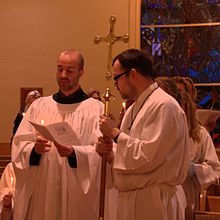 Candlemas (also spelled Candlemass), also known as the Feast of the Presentation of Jesus Christ, the Feast of the Purification of the Blessed Virgin Mary, and the Feast of the Holy Encounter, is a Christian Holy Day commemorating the presentation of Jesus at the Temple. It is based upon the account of the presentation of Jesus in Luke 2:22–40. In accordance with Leviticus 12: a woman was to be purified by presenting a lamb as a burnt offering, and either a young pigeon or dove as sin offering, 33 days after a boy's circumcision. It falls on February 2, which is traditionally the 40th day of and the conclusion of the Christmas–Epiphany season.
While it is customary for Christians in some countries to remove their Christmas decorations on Twelfth Night (Epiphany Eve), those in other Christian countries historically remove them on Candlemas. On Candlemas, many Christians (especially Anglicans, Methodists, Lutherans, Orthodox and Roman Catholics) also bring their candles to their local church, where they are blessed and then used for the rest of the year; for Christians, these blessed candles serve as a symbol of Jesus Christ, who referred to Himself as the Light of the World.
History
Candlemas (also spelled Candlemass), also known as the Feast of the Presentation of Jesus Christ, the Feast of the Purification of the Blessed Virgin Mary, and the Feast of the Holy Encounter, is a Christian Holy Day commemorating the presentation of Jesus at the Temple. It is based upon the account of the presentation of Jesus in Luke 2:22–40. In accordance with Leviticus 12: a woman was to be purified by presenting a lamb as a burnt offering, and either a young pigeon or dove as sin offering, 33 days after a boy's circumcision. It falls on February 2, which is traditionally the 40th day of and the conclusion of the Christmas–Epiphany season.
While it is customary for Christians in some countries to remove their Christmas decorations on Twelfth Night (Epiphany Eve), those in other Christian countries historically remove them on Candlemas. On Candlemas, many Christians (especially Anglicans, Methodists, Lutherans, Orthodox and Roman Catholics) also bring their candles to their local church, where they are blessed and then used for the rest of the year; for Christians, these blessed candles serve as a symbol of Jesus Christ, who referred to Himself as the Light of the World.
History
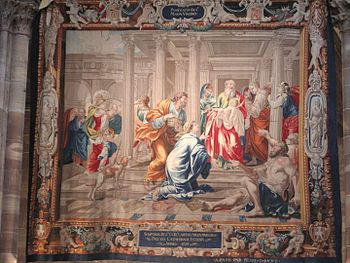 The Feast of the Presentation of Jesus at the Temple being celebrated through Mass at the Mikael Agricola Lutheran Church in Helsinki (2015).
The Feast of the Presentation is one of the oldest feasts of the Christian church, celebrated since the 4th century AD in Jerusalem. There are sermons on the Feast by the bishops Methodius of Patara (died 312), Cyril of Jerusalem (died 360), Gregory the Theologian (died 389), Amphilochius of Iconium (died 394), Gregory of Nyssa (died 400), and John Chrysostom (died 407). It is also mentioned in the pilgrimage of Egeria (381–384), where she confirmed that the celebrations took place in honor of the presentation of Jesus at the Temple.
The Feast of the Presentation of Jesus at the Temple being celebrated through Mass at the Mikael Agricola Lutheran Church in Helsinki (2015).
The Feast of the Presentation is one of the oldest feasts of the Christian church, celebrated since the 4th century AD in Jerusalem. There are sermons on the Feast by the bishops Methodius of Patara (died 312), Cyril of Jerusalem (died 360), Gregory the Theologian (died 389), Amphilochius of Iconium (died 394), Gregory of Nyssa (died 400), and John Chrysostom (died 407). It is also mentioned in the pilgrimage of Egeria (381–384), where she confirmed that the celebrations took place in honor of the presentation of Jesus at the Temple.
XXVI. [The Purification of the Blessed Virgin Mary.] But certainly the Feast of the Purification is celebrated here with the greatest honour. On this day there is a procession to the Anastasis; all go in procession, and all things are done in order with great joy, just as at Easter. All the priests preach, and also the bishop, always treating of that passage of the Gospel106 where, on the fortieth day, Joseph and Mary brought the Lord into the Temple, and Simeon and Anna the prophetess, the daughter of Famuhel, saw Him, and of the words which they said when they saw the Lord, and of the offerings which the parents presented. And when all things have been celebrated in order as is customary, the sacrament is administered, and so the people are dismissed.
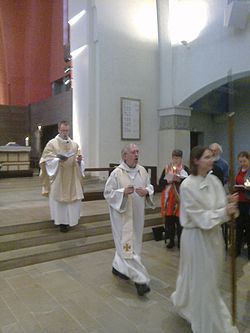 Christmas was, in the West, celebrated on December 25 from at least the year AD 354 when it was fixed by Pope Liberius. Forty days after December 25 is February 2. In the Eastern parts of the Roman Empire, Roman consul Justin established the celebration of the Hypapante (i.e. Presentation of Jesus in the Temple) on February 2, AD 521.
Pope Gelasius I (492–496) contributed to the spread of the celebration, but clearly did not invent it. Moreover, the link made by Caesar Baronius between the presentation of Jesus and Lupercalia is probably inaccurate since Lupercalia was not celebrated in Jerusalem and it was only there that one finds some celebrations of the presentation of Jesus around this date. But it appears that it became important around the time of the Plague of Justinian (the first old world pandemic of the plague) in 541, before slowly spreading West. The ancient Romans celebrated the Lupercalia in mid-February, in honor of Lupercus, the god of fertility and shepherds. The celebration of Feralia (a roman public festival celebrating the spirits of the dead) occurred at the same time.
The Lupercalia has frequently been linked to the presentation of Jesus at the temple, particularly by Cardinal Caesar Baronius in the 16th century especially because of the theme of purification that the two festivals share. In fact, Pope Gelasius I had much earlier written a letter to a senator Andromachus, who wanted to reestablish the Lupercalia for the purpose of purification; and the so-called Gelasian Sacramentary mentions the celebration of the Presentation of Jesus, lending support to the conclusion that Gelasius substituted a Christian festival for a pagan one. However the Gelasian Sacramentary shows a strong Gallican influence and was actually compiled between AD 628 and AD 731, so it is possible that the addition of the celebration was not due to Pope Gelasius at all. Moreover, when Gelasius addressed Andromachus, he did not try to use his authority, but contented himself to arguing for example that the Lupercalia would no longer have the effect it once had and was incompatible with Christian ideals. This could be interpreted as evidence that he had limited influence on the Roman aristocracy.
Centuries later, around the year 1392 or 1400, an image of the Virgin Mary that represented this invocation, was found on the seashore by two Guanche shepherds from the island of Tenerife (Canary Islands). After the appearance of the Virgin and its iconographic identification with this biblical event, the festival began to be celebrated with a Marian character in the year 1497, when the conqueror Alonso Fernández de Lugo celebrated the first Candlemas festival dedicated especially to the Virgin Mary, coinciding with the Feast of Purification on February 2. Before the conquest of Tenerife, the Guanche aborigines celebrated a festivity around the image of the Virgin during the Beñesmen festival in the month of August. This was the harvest party, which marked the beginning of the year. Currently, the feast of the Virgin of Candelaria in the Canary Islands is celebrated in addition to February 2 also on August 15, the day of the Assumption of the Virgin Mary in the Catholic calendar. For some historians, the celebrations celebrated in honor of the Virgin during the month of August are a syncretized reminiscence of the ancient feasts of the Beñesmen.
In Swedish and Finnish Lutheran Churches, Candlemas is (since 1774) always celebrated on a Sunday, at the earliest on 2 February and at the latest on 8 February, except if this Sunday happens to be the last Sunday before Lent, i.e. Shrove Sunday or Quinquagesima (Swedish: Fastlagssöndagen, Finnish: Laskiaissunnuntai), in which case Candlemas is celebrated one week earlier.
Celebrations
Christmas was, in the West, celebrated on December 25 from at least the year AD 354 when it was fixed by Pope Liberius. Forty days after December 25 is February 2. In the Eastern parts of the Roman Empire, Roman consul Justin established the celebration of the Hypapante (i.e. Presentation of Jesus in the Temple) on February 2, AD 521.
Pope Gelasius I (492–496) contributed to the spread of the celebration, but clearly did not invent it. Moreover, the link made by Caesar Baronius between the presentation of Jesus and Lupercalia is probably inaccurate since Lupercalia was not celebrated in Jerusalem and it was only there that one finds some celebrations of the presentation of Jesus around this date. But it appears that it became important around the time of the Plague of Justinian (the first old world pandemic of the plague) in 541, before slowly spreading West. The ancient Romans celebrated the Lupercalia in mid-February, in honor of Lupercus, the god of fertility and shepherds. The celebration of Feralia (a roman public festival celebrating the spirits of the dead) occurred at the same time.
The Lupercalia has frequently been linked to the presentation of Jesus at the temple, particularly by Cardinal Caesar Baronius in the 16th century especially because of the theme of purification that the two festivals share. In fact, Pope Gelasius I had much earlier written a letter to a senator Andromachus, who wanted to reestablish the Lupercalia for the purpose of purification; and the so-called Gelasian Sacramentary mentions the celebration of the Presentation of Jesus, lending support to the conclusion that Gelasius substituted a Christian festival for a pagan one. However the Gelasian Sacramentary shows a strong Gallican influence and was actually compiled between AD 628 and AD 731, so it is possible that the addition of the celebration was not due to Pope Gelasius at all. Moreover, when Gelasius addressed Andromachus, he did not try to use his authority, but contented himself to arguing for example that the Lupercalia would no longer have the effect it once had and was incompatible with Christian ideals. This could be interpreted as evidence that he had limited influence on the Roman aristocracy.
Centuries later, around the year 1392 or 1400, an image of the Virgin Mary that represented this invocation, was found on the seashore by two Guanche shepherds from the island of Tenerife (Canary Islands). After the appearance of the Virgin and its iconographic identification with this biblical event, the festival began to be celebrated with a Marian character in the year 1497, when the conqueror Alonso Fernández de Lugo celebrated the first Candlemas festival dedicated especially to the Virgin Mary, coinciding with the Feast of Purification on February 2. Before the conquest of Tenerife, the Guanche aborigines celebrated a festivity around the image of the Virgin during the Beñesmen festival in the month of August. This was the harvest party, which marked the beginning of the year. Currently, the feast of the Virgin of Candelaria in the Canary Islands is celebrated in addition to February 2 also on August 15, the day of the Assumption of the Virgin Mary in the Catholic calendar. For some historians, the celebrations celebrated in honor of the Virgin during the month of August are a syncretized reminiscence of the ancient feasts of the Beñesmen.
In Swedish and Finnish Lutheran Churches, Candlemas is (since 1774) always celebrated on a Sunday, at the earliest on 2 February and at the latest on 8 February, except if this Sunday happens to be the last Sunday before Lent, i.e. Shrove Sunday or Quinquagesima (Swedish: Fastlagssöndagen, Finnish: Laskiaissunnuntai), in which case Candlemas is celebrated one week earlier.
Celebrations
France, Belgium, and Swiss Romandy
 Candlemas (French: La Chandeleur) is celebrated in the churches on February 2. It is also considered the day of crêpes. Tradition attributes this custom to Pope Gelasius I, who had pancakes distributed to pilgrims arriving in Rome, but as mentioned earlier one can also see it as a vestige of the custom of Vestal Virgins making offerings of cakes at the time of the Lupercalia.
To celebrate Candlemas, all the candles in the house should be lit. Tradition also says manger scenes should not be put away until Candlemas, which is the last feast of the Christmas cycle.
It is also said that the pancakes, with their round shape and golden color reminiscent of the solar disc, refer to the return of Spring after the dark and cold of Winter.
Even today there is a certain symbolism associated with the preparation of the crêpes. A tradition dating back to the late fifth century and linked to a fertility rite is to flip the crepes in the air with the right hand while holding a gold coin (such as a Louis d'or) or some other coin in the left hand, in order to have prosperity throughout the year. One has to ensure that the pancake lands properly back in the pan. It is also said that the first crepe made should be kept in an armoire to ensure a plentiful harvest later in the year. It is sometimes specified that it be placed at the top of the armoire, and the pancake will supposedly not get moldy and will keep misery and deprivation far away.
Luxembourg
Being a descendant of an ancient torchlight procession, in Luxembourg the current tradition of Luxembourgish: Liichtmëssdag is a holiday centered around children. In small groups, they roam the streets in the afternoon or evening of February 2, holding a lighted lantern or homemade wand, singing traditional songs at each house or store, especially "Léiwer Härgottsblieschen". In exchange for the music, they hope to receive a reward in the form of sweets or loose change (formerly bacon, peas, or biscuits).
Puerto Rico
This festivity officially finalizes the end of Christmas for Christians in Puerto Rico; the festivities include a procession where the statue of the "Virgen de la Candelaria" is carried on the shoulders. Others follow with lit candles until they reach a church where a Mass is celebrated. In the evening, the festivities continue with a giant bonfire and singing.
Tenerife and Philippines
Candlemas (French: La Chandeleur) is celebrated in the churches on February 2. It is also considered the day of crêpes. Tradition attributes this custom to Pope Gelasius I, who had pancakes distributed to pilgrims arriving in Rome, but as mentioned earlier one can also see it as a vestige of the custom of Vestal Virgins making offerings of cakes at the time of the Lupercalia.
To celebrate Candlemas, all the candles in the house should be lit. Tradition also says manger scenes should not be put away until Candlemas, which is the last feast of the Christmas cycle.
It is also said that the pancakes, with their round shape and golden color reminiscent of the solar disc, refer to the return of Spring after the dark and cold of Winter.
Even today there is a certain symbolism associated with the preparation of the crêpes. A tradition dating back to the late fifth century and linked to a fertility rite is to flip the crepes in the air with the right hand while holding a gold coin (such as a Louis d'or) or some other coin in the left hand, in order to have prosperity throughout the year. One has to ensure that the pancake lands properly back in the pan. It is also said that the first crepe made should be kept in an armoire to ensure a plentiful harvest later in the year. It is sometimes specified that it be placed at the top of the armoire, and the pancake will supposedly not get moldy and will keep misery and deprivation far away.
Luxembourg
Being a descendant of an ancient torchlight procession, in Luxembourg the current tradition of Luxembourgish: Liichtmëssdag is a holiday centered around children. In small groups, they roam the streets in the afternoon or evening of February 2, holding a lighted lantern or homemade wand, singing traditional songs at each house or store, especially "Léiwer Härgottsblieschen". In exchange for the music, they hope to receive a reward in the form of sweets or loose change (formerly bacon, peas, or biscuits).
Puerto Rico
This festivity officially finalizes the end of Christmas for Christians in Puerto Rico; the festivities include a procession where the statue of the "Virgen de la Candelaria" is carried on the shoulders. Others follow with lit candles until they reach a church where a Mass is celebrated. In the evening, the festivities continue with a giant bonfire and singing.
Tenerife and Philippines
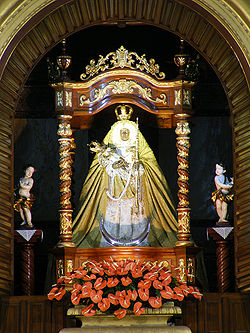 The Virgin of Candelaria or Our Lady of Candelaria (Spanish: Virgen de Candelaria or Nuestra Señora de la Candelaria), popularly called La Morenita, celebrates the Virgin Mary on the island of Tenerife, one of the Canary Islands (Spain). The center of worship is located in the city of Candelaria in Tenerife. She is depicted as a Black Madonna. The "Royal Basilica Marian Shrine of Our Lady of Candelaria" (Basilica of Candelaria) is considered the main church dedicated to the Virgin Mary in the Canary Islands. Her feast is celebrated on February 2 (Fiesta de la Candelaria) and August 15, the patronal feast of the Canary Islands.
In the Philippines, she is also the patroness of Western Visayas region enshrined in Jaro Cathedral or the National Shrine of Our Lady of Candles under the Archdiocese of Jaro (with feast day every 2 February), and Barangay Tatala in Binangonan, Rizal, which celebrates her feast on the First Saturday of February. In Silang, Cavite, her feast is observed locally as a triduum from February 1 to 3, with February 2 kept as the actual feast day.
Guatemala
The Virgin of Candelaria is the patron saint of Jacaltenango and her feast is celebrated on February 2, marking the end of the Christmas season.
Mexico
In Mexico, it is traditional to celebrate the presentation of the Christ child in the temple on February 2. The dressing and adoration of the child Jesus and family meals with tamales are an important Mexican tradition.
This festival is closely linked to that of the Epiphany, during which the tasting of the rosca de reyes (kings cake) will determine who is responsible for organizing Candlemas. Whoever finds the muñeco (bean-shaped Christ child) in the cake is named godfather of the child, who will then dress the niño dios (an image of the Christ child in the form of a doll) on Candlemas with richly decorated clothes, which is then brought to the church to be blessed. Memories of these events are often passed down from generation to generation in families.
Following this is the family meal. Whoever draws the bean on Epiphany must also prepare tamales, which is believed to echo Mexico's pre-Christian past with its offerings of maize. The whole family is invited to this meal (often the same people as for the Rosca at Epiphany), which gives the festival an aspect of family and sharing. These celebrations take place not only in Mexico but also in Mexican communities around the world, for instance in France. It is for this reason that the Mexican tradition also appears in the Inventory of intangible cultural heritage in France.
Peru
The Virgin of Candelaria or Our Lady of Candelaria (Spanish: Virgen de Candelaria or Nuestra Señora de la Candelaria), popularly called La Morenita, celebrates the Virgin Mary on the island of Tenerife, one of the Canary Islands (Spain). The center of worship is located in the city of Candelaria in Tenerife. She is depicted as a Black Madonna. The "Royal Basilica Marian Shrine of Our Lady of Candelaria" (Basilica of Candelaria) is considered the main church dedicated to the Virgin Mary in the Canary Islands. Her feast is celebrated on February 2 (Fiesta de la Candelaria) and August 15, the patronal feast of the Canary Islands.
In the Philippines, she is also the patroness of Western Visayas region enshrined in Jaro Cathedral or the National Shrine of Our Lady of Candles under the Archdiocese of Jaro (with feast day every 2 February), and Barangay Tatala in Binangonan, Rizal, which celebrates her feast on the First Saturday of February. In Silang, Cavite, her feast is observed locally as a triduum from February 1 to 3, with February 2 kept as the actual feast day.
Guatemala
The Virgin of Candelaria is the patron saint of Jacaltenango and her feast is celebrated on February 2, marking the end of the Christmas season.
Mexico
In Mexico, it is traditional to celebrate the presentation of the Christ child in the temple on February 2. The dressing and adoration of the child Jesus and family meals with tamales are an important Mexican tradition.
This festival is closely linked to that of the Epiphany, during which the tasting of the rosca de reyes (kings cake) will determine who is responsible for organizing Candlemas. Whoever finds the muñeco (bean-shaped Christ child) in the cake is named godfather of the child, who will then dress the niño dios (an image of the Christ child in the form of a doll) on Candlemas with richly decorated clothes, which is then brought to the church to be blessed. Memories of these events are often passed down from generation to generation in families.
Following this is the family meal. Whoever draws the bean on Epiphany must also prepare tamales, which is believed to echo Mexico's pre-Christian past with its offerings of maize. The whole family is invited to this meal (often the same people as for the Rosca at Epiphany), which gives the festival an aspect of family and sharing. These celebrations take place not only in Mexico but also in Mexican communities around the world, for instance in France. It is for this reason that the Mexican tradition also appears in the Inventory of intangible cultural heritage in France.
Peru
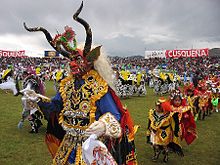 The Virgin of Candelaria is the patron saint of the city of Puno in Peru, held in the first fortnight of February each year. It is one of the largest festivals of culture, music and dancing in Peru. In terms of the number of events related to the cultures of the Quechua and Aymara peoples and of the mestizos of the Altiplano, and also in terms of the number of people directly and indirectly involved in its realization, it stands with the Carnival in Rio de Janeiro and the Carnaval de Oruro in Bolivia as one of the three largest festivals in South America.
At the core of the festival are performances of music and dance organized by the Federación Regional de Folklore y Cultura de Puno [es], consisting of more than 200 dances in more than 150 dance sets. These include "native dances" from the various communities in Puno and sets of dances organized in different quarters of the city, mostly those known as "costume dances". These performances directly involve 40,000 dancers and some 5,000 musicians, and indirectly involve about 25,000 people including directors, sponsors, embroiderers and the makers of masks, clothing, boots, shoes, bells and other items.
The Virgin of Candelaria is the patron saint of the city of Puno in Peru, held in the first fortnight of February each year. It is one of the largest festivals of culture, music and dancing in Peru. In terms of the number of events related to the cultures of the Quechua and Aymara peoples and of the mestizos of the Altiplano, and also in terms of the number of people directly and indirectly involved in its realization, it stands with the Carnival in Rio de Janeiro and the Carnaval de Oruro in Bolivia as one of the three largest festivals in South America.
At the core of the festival are performances of music and dance organized by the Federación Regional de Folklore y Cultura de Puno [es], consisting of more than 200 dances in more than 150 dance sets. These include "native dances" from the various communities in Puno and sets of dances organized in different quarters of the city, mostly those known as "costume dances". These performances directly involve 40,000 dancers and some 5,000 musicians, and indirectly involve about 25,000 people including directors, sponsors, embroiderers and the makers of masks, clothing, boots, shoes, bells and other items.